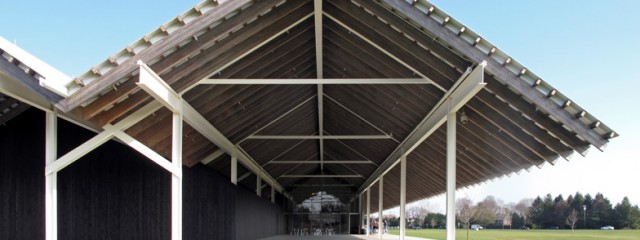This may look like a pair of barns in a field, but its actually the new home that Swiss architecture studio Herzog & de Meuron has completed for the Parrish Art Museum on Long Island.
Herzog & de Meuron drew inspiration from the archetypal house to create the two gabled structures that comprise the building, which is reminiscent of the stacked volumes the architects created for the VitraHaus furniture gallery in Germany.
“Our design for the Parrish Art Museum is a reinterpretation of a very genuine Herzog & de Meuron typology, the traditional house form,” said Jacques Herzog. “What we like about this typology is that it is open for many different functions, places and cultures. Each time this simple, almost banal form has become something very specific, precise and also fresh.”
Galleries and other rooms are arranged in two parallel rows beneath the shallow-pitched roofs, while a long corridor is sandwiched between to create a run of ten sub-divisible exhibition spaces at the centre.
“All galleries have large north-facing and small south-facing skylights, which fill the spaces with ever-changing daylight and allow direct views to the sky and the clouds passing by,” said Herzog & de Meuron senior partner Ascan Mergenthaler.
Overhanging eaves create sheltered terraces around the building’s perimeter, including a cafe terrace that the gallery hopes to use for events, workshops and performances.
Chairs and tables designed by Konstantin Grcic furnish this terrace and offer visitors a place to look out across the surrounding meadows.
The new building doubles the size of the museum’s previous Southampton home on Jobs Lane, where the arts institution had been based since it was first established in 1897.
The galleries open with a special exhibition celebrating the work of artist Malcolm Morley, while the permanent collection will contain artworks from the nineteenth century onwards.
The architects revealed the finalised designs for the building in 2009, following a series of budget cuts that forced them to reconsider their original concept.
Here’s a design statement from Herzog & de Meuron:
The starting point for the new Parrish Art Museum is the artist’s studio in the East End of Long Island. We set the basic parameters for a single gallery space by distilling the studio’s proportions and adopting its simple house section with north-facing skylights. Two of these model galleries form wings around a central circulation spine that is then bracketed by two porches to form the basis of a straightforward building extrusion.
The floor plan of this extrusion is a direct translation of the ideal functional layout. A cluster of ten galleries defines the heart of the museum. The size and proportion of these galleries can be easily adapted by re-arranging partition walls within the given structural grid. To the east of the gallery core are located the back of house functions of administration, storage, workshops and loading dock. To the west of the galleries are housed the public program areas of the lobby, shop, and café with a flexible multi-purpose and educational space at the far western end.
An ordered sequence of post, beam and truss defines the unifying backbone of the building. Its materialisation is a direct expression of readily accessible building materials and local construction methods.
The exterior walls of in situ concrete act as long bookends to the overall building form, while the grand scale of these elemental walls is tempered with a continuous bench formed at its base for sitting and viewing the surrounding landscape. Large overhangs running the full length of the building provide shelter for outdoor porches and terraces.
The placement of the building is a direct result of the skylights facing towards the north. This east-west orientation, and its incidental diagonal relationship within the site, generates dramatically changing perspective views of the building and further emphasises the building’s extreme yet simple proportions. It lays in an extensive meadow of indigenous grasses that refers to the natural landscape of Long Island.

















2 Comments
Yo también hubiera gustado ver una sección. Espero visitarlo para ver como funciona con el arte.
Lastima que no publiqueis las plantas. Interesante la solución del zocalo-banco.